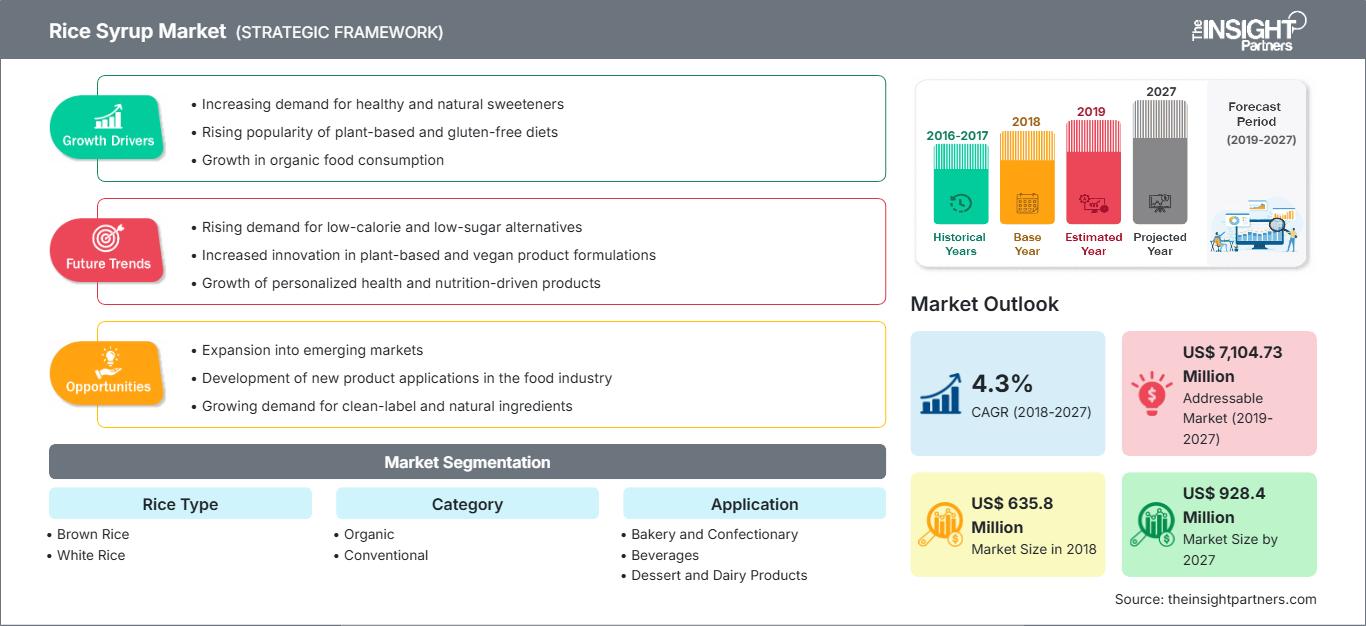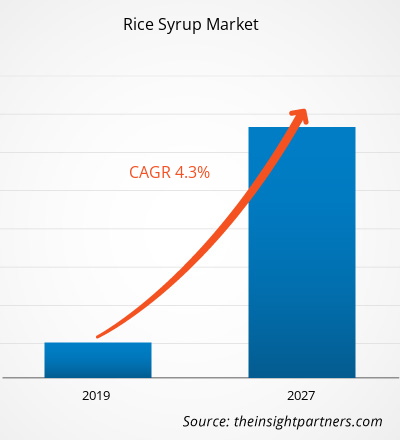Der Markt für Reissirup hatte 2018 einen Wert von 635,8 Millionen US-Dollar und soll bis 2027 928,4 Millionen US-Dollar erreichen; von 2019 bis 2027 wird ein durchschnittliches jährliches Wachstum von 4,3 % erwartet.
Reissirup ist die verarbeitete Form von Kulturreis. Der Reis wird mithilfe von Beta- und Alpha-Amylase-Enzymen fermentiert, die die Stärke in einfache Zuckermoleküle wie Glucose, Maltose und Fructose zerlegen. Aufgrund der hohen Stärkekonzentration wird Reissirup als Süßungsmittel oder Süßverstärker in der Lebensmittelverarbeitung eingesetzt. Verarbeitungs- und Raffinationsprozesse verringern jedoch den Nährwert des Sirups. Der Markt wird durch die breite Anwendung von Reissirup als alternatives Süßungsmittel angetrieben. Reissirup ist als flüssige Lösung eines nahrhaften Süßungsmittels erhältlich. Darüber hinaus treibt die steigende Beliebtheit von Bio-Reissirup aufgrund des wachsenden Gesundheitsbewusstseins der Verbraucher das Wachstum des Reissirupmarktes voran.
Im Jahr 2018 hatte der asiatisch-pazifische Raum den größten Anteil am globalen Reissirupmarkt, während Nordamerika im Prognosezeitraum voraussichtlich die schnellste durchschnittliche jährliche Wachstumsrate verzeichnen wird. Im asiatisch-pazifischen Raum wird die Nachfrage nach Reissirup aufgrund der allmählichen Umstellung der Verbraucher auf Fertiggerichte voraussichtlich steigen. Die Verbraucher in entwickelten und sich entwickelnden asiatischen Ländern wie Australien, China und Indien sind stark auf ihr Berufsleben ausgerichtet, was sich in einer hohen Nachfrage nach Fertiggerichten oder Lebensmitteln für unterwegs widerspiegelt. Die zunehmende Urbanisierung, das steigende verfügbare Einkommen und der Anstieg der ausländischen Direktinvestitionen im Einzelhandel sind weitere Schlüsselfaktoren, die das Wachstum des Reissirupmarktes in dieser Region ankurbeln.
Passen Sie diesen Bericht Ihren Anforderungen an
Sie erhalten kostenlos Anpassungen an jedem Bericht, einschließlich Teilen dieses Berichts oder einer Analyse auf Länderebene, eines Excel-Datenpakets sowie tolle Angebote und Rabatte für Start-ups und Universitäten.
Reissirupmarkt: Strategische Einblicke

-
Holen Sie sich die wichtigsten Markttrends aus diesem Bericht.Dieses KOSTENLOSE Beispiel umfasst Datenanalysen, die von Markttrends bis hin zu Schätzungen und Prognosen reichen.
Der COVID-19-Ausbruch begann im Dezember 2019 in Wuhan (China) und hat sich seitdem rasant weltweit verbreitet. Im März 2020 gehörten China, Italien, Iran, Spanien, die Republik Korea, Frankreich, Deutschland und die USA zu den am stärksten betroffenen Ländern hinsichtlich bestätigter Fälle und gemeldeter Todesfälle. Der Ausbruch hat aufgrund von Ausgangssperren, Reiseverboten und Geschäftsschließungen die Wirtschaft und Industrie in zahlreichen Ländern beeinträchtigt. Die Lebensmittel- und Getränkeindustrie ist eine der wichtigsten Branchen, die infolge dieses Ausbruchs unter schweren Störungen wie Büro- und Fabrikschließungen, Unterbrechungen der Lieferkette und der Absage von Technologieveranstaltungen leidet.
Markteinblicke Steigende Nachfrage nach Fertiggerichten
Die Nachfrage nach Reissirup steigt aufgrund der wachsenden Vorliebe der Verbraucher für verarbeitete Lebensmittel oder Fertiggerichte. Reissirup wird in Fertiggerichten wie Back- und Süßwaren, Milchprodukten, Fertiggerichten, Tiefkühldesserts und Getränken für unterwegs verwendet, um deren Geschmack zu verbessern. Mit dem Wachstum der Lebensmittel- und Getränkeindustrie und dem steigenden Einkommensniveau neigen Verbraucher in Industrie- und Entwicklungsländern immer mehr zu Fertiggerichten. Zudem ziehen innovative Verpackungsmethoden aufgrund der technologischen Entwicklung mehr Verbraucher in den Bann dieser Lebensmittel. Der weltweit steigende Bedarf an Lebensmitteln wird derzeit größtenteils durch Fertiggerichte gedeckt. Die Urbanisierung der Gesellschaft hat dazu geführt, dass diese Lebensmittel in der modernen Ernährung eine wichtige Rolle spielen; so wird beispielsweise zum Frühstück immer häufiger Reissirup gemischt mit Sprudelwasser, Kaffee, Pfannkuchen, Waffeln, Tee, Kuchen usw. konsumiert. Darüber hinaus steigern das Bevölkerungswachstum in Verbindung mit einem steigenden Wirtschaftsstandard, einem Anstieg des verfügbaren Einkommens und einer Diversifizierung der Ernährungsgewohnheiten die Nachfrage nach Fertiggerichten. Um der steigenden Nachfrage gerecht zu werden, entwickeln Unternehmen qualitativ bessere Reissirupe und effiziente Vertriebskanäle, um einen breiteren Kundenstamm bedienen zu können.
Einblicke nach Reissorten
Der Reissirupmarkt ist je nach Reissorte in Naturreis und Weißreis unterteilt. Im Jahr 2018 hatte Naturreis einen größeren Anteil am Weltmarkt, während für Weißreis im Prognosezeitraum eine höhere durchschnittliche jährliche Wachstumsrate (CAGR) erwartet wird. Naturreis-Sirup ist auch als Reismalzsirup bekannt. Auf die Fermentation von Naturreis folgt ein enzymatischer Abbau der Stärke; die Substanz wird dann reduziert, bis sie eine sirupartige Konsistenz annimmt. Die Nachfrage nach Naturreis-Sirup steigt aufgrund seiner Nährwerte weltweit an. Diese Art von Reissirup wird in vielen gesunden und biologischen Lebensmitteln wie Snackriegeln oder Frühstücksflocken als Alternative zu künstlichen Süßstoffen, Weißzucker und Maissirup mit hohem Fructosegehalt verwendet.
Kategoriebasierte Erkenntnisse
Der Reissirupmarkt ist nach Kategorien in biologisch und konventionell unterteilt. Im Jahr 2018 hatte das biologische Segment einen größeren Marktanteil, während für das konventionelle Segment im Prognosezeitraum eine höhere durchschnittliche jährliche Wachstumsrate (CAGR) erwartet wird. Bio-Reissirup ist natürlich, glutenfrei, nicht gentechnisch verändert und allergenfrei. Da Bio-Reissirup aus pflanzlichen Quellen hergestellt wird, eignet er sich für vegane oder vegetarische Lebensmittel. Er dient auch als Süßungsmittel in Müsli, Snackriegeln, Tee, Kaffee, Säften und Backwaren. Darüber hinaus wird es auch als gesundes, hypoallergenes Nahrungsergänzungsmittel eingenommen, das bei der Bekämpfung von Diabetes und anderen Krankheiten hilft.
Anwendungsbasierte Erkenntnisse
Der Reissirupmarkt ist je nach Anwendung in Back- und Süßwaren, Getränke, Desserts und Milchprodukte, Fleisch-, Geflügel- und Meeresfrüchteprodukte, Säuglingsnahrung und andere segmentiert. Im Jahr 2018 hatte das Segment Back- und Süßwaren den größten Anteil am Weltmarkt, während das Segment Desserts und Milchprodukte im Prognosezeitraum voraussichtlich die höchste durchschnittliche jährliche Wachstumsrate verzeichnen wird. Die Dominanz dieses Segments ist hauptsächlich auf die steigende Nachfrage nach Back- und Süßwaren in den Schwellenländern im asiatisch-pazifischen Raum zurückzuführen. Reissirup ist eine geruchlose, süße und klare, gelbe, viskose Flüssigkeit und wird in Back- und Süßwarenprodukten verwendet, die einen hohen Anteil an Invertzucker erfordern. Reissirup wird zunehmend zum Backen von Lebensmitteln wie Keksen, Kuchen und Muffins sowie zur Herstellung von Bonbons, Pfannkuchen, Muffins, Gummibärchen und Gelees verwendet. Er verleiht Back- und Süßwaren Viskosität, Textur und Stabilität. Darüber hinaus wird er auch zum Dekorieren von Lebensmitteln verwendet, da er ihnen Glanz und Köstlichkeit verleiht. Dies steigert die Nachfrage in Restaurants und Cafés.
Unternehmen greifen häufig auf verschiedene strategische Initiativen zurück, um ihre Präsenz weltweit auszubauen. Akteure auf dem Reissirupmarkt wie Gulshan Polyols Limited, Cargill Incorporated, Wuhu Deli Foods Co., Ltd. und Malt Products Corporation setzen diese Strategie um, um ihren Kundenstamm zu erweitern und bedeutende Marktanteile auf dem Weltmarkt zu gewinnen. Dies ermöglicht ihnen auch, ihren Markennamen weltweit zu behaupten.
Reissirupmarkt
Die Analysten von The Insight Partners haben die regionalen Trends und Faktoren, die den Reissirupmarkt im Prognosezeitraum beeinflussen, ausführlich erläutert. In diesem Abschnitt werden auch die Marktsegmente und die geografische Lage in Nordamerika, Europa, Asien-Pazifik, dem Nahen Osten und Afrika sowie Süd- und Mittelamerika erörtert.Umfang des Marktberichts über Reissirup
| Berichtsattribut | Einzelheiten |
|---|---|
| Marktgröße in 2018 | US$ 635.8 Million |
| Marktgröße nach 2027 | US$ 928.4 Million |
| Globale CAGR (2018 - 2027) | 4.3% |
| Historische Daten | 2016-2017 |
| Prognosezeitraum | 2019-2027 |
| Abgedeckte Segmente |
By Reissorte
|
| Abgedeckte Regionen und Länder |
Nordamerika
|
| Marktführer und wichtige Unternehmensprofile |
|
Dichte der Marktteilnehmer im Reissirupmarkt: Verständnis ihrer Auswirkungen auf die Geschäftsdynamik
Der Reissirupmarkt wächst rasant. Die steigende Nachfrage der Endverbraucher ist auf Faktoren wie veränderte Verbraucherpräferenzen, technologische Fortschritte und ein stärkeres Bewusstsein für die Produktvorteile zurückzuführen. Mit der steigenden Nachfrage erweitern Unternehmen ihr Angebot, entwickeln Innovationen, um den Bedürfnissen der Verbraucher gerecht zu werden, und nutzen neue Trends, was das Marktwachstum weiter ankurbelt.
- Holen Sie sich die Reissirupmarkt Übersicht der wichtigsten Akteure
- Naturreis
- Weißer Reis
Globaler Markt für Reissirup – nach Anwendung
- Bäckereien und Süßwaren
- Getränke
- Desserts und Milchprodukte
- Fleisch-, Geflügel- und Meeresfrüchteprodukte
- Säuglingsnahrung
- Sonstige
Globaler Markt für Reissirup – Nach Kategorie
- Bio
- Konventionell
Firmenprofile
- Axiom Foods, Inc.
- Malt Products Corporation
- California Natural Products
- Cargill, Incorporated
- Gulshan Polyols Ltd
- Habib Rice Products Ltd
- Lundberg
- Meurens Natural
- Windmill Organics Ltd
- Wuhu Deli Foods Co., Ltd
- Historische Analyse (2 Jahre), Basisjahr, Prognose (7 Jahre) mit CAGR
- PEST- und SWOT-Analyse
- Marktgröße Wert/Volumen – Global, Regional, Land
- Branchen- und Wettbewerbslandschaft
- Excel-Datensatz
Aktuelle Berichte
Verwandte Berichte
Erfahrungsberichte
Grund zum Kauf
- Fundierte Entscheidungsfindung
- Marktdynamik verstehen
- Wettbewerbsanalyse
- Kundeneinblicke
- Marktprognosen
- Risikominimierung
- Strategische Planung
- Investitionsbegründung
- Identifizierung neuer Märkte
- Verbesserung von Marketingstrategien
- Steigerung der Betriebseffizienz
- Anpassung an regulatorische Trends






















 Kostenlose Probe anfordern für - Reissirupmarkt
Kostenlose Probe anfordern für - Reissirupmarkt